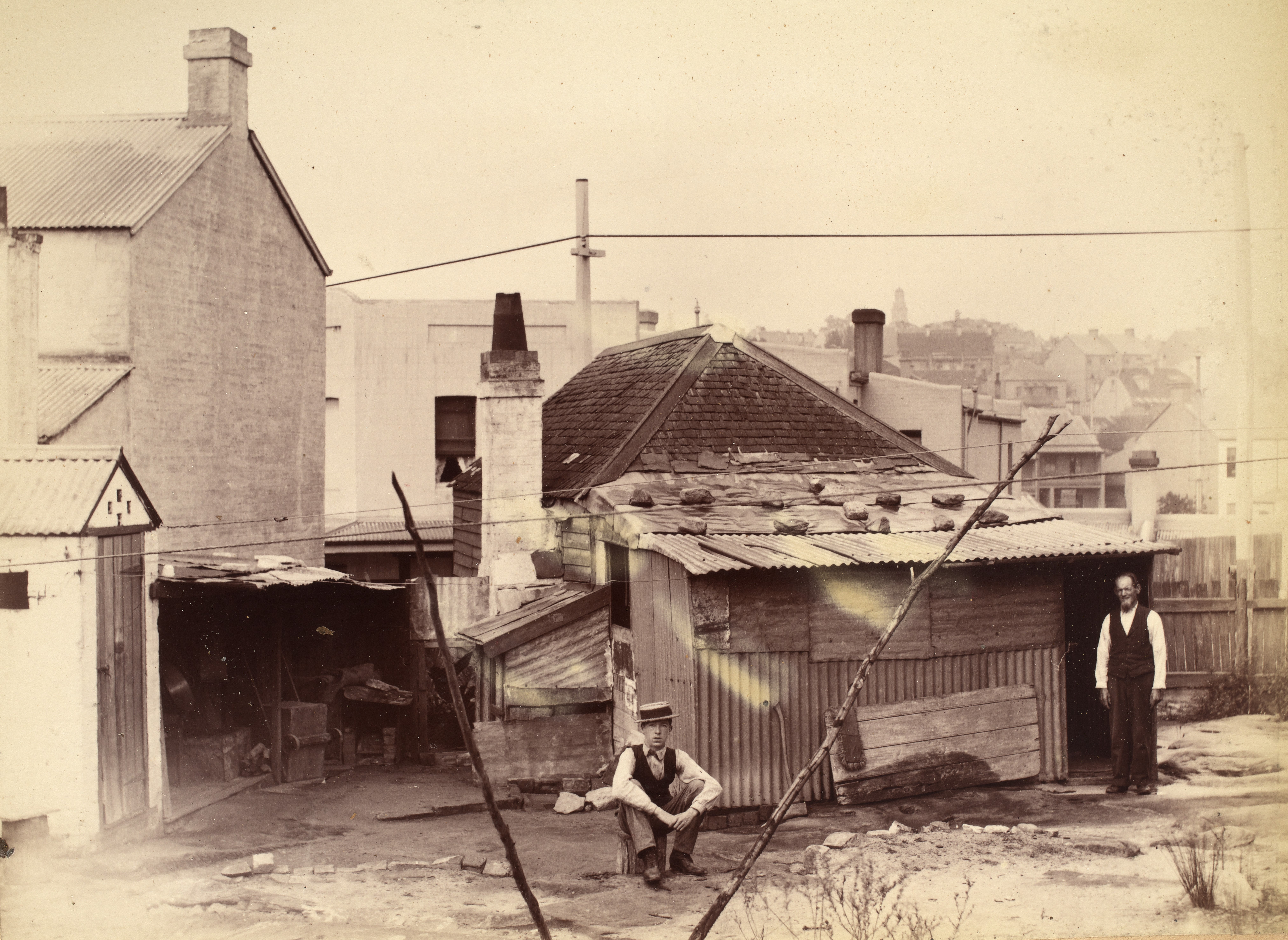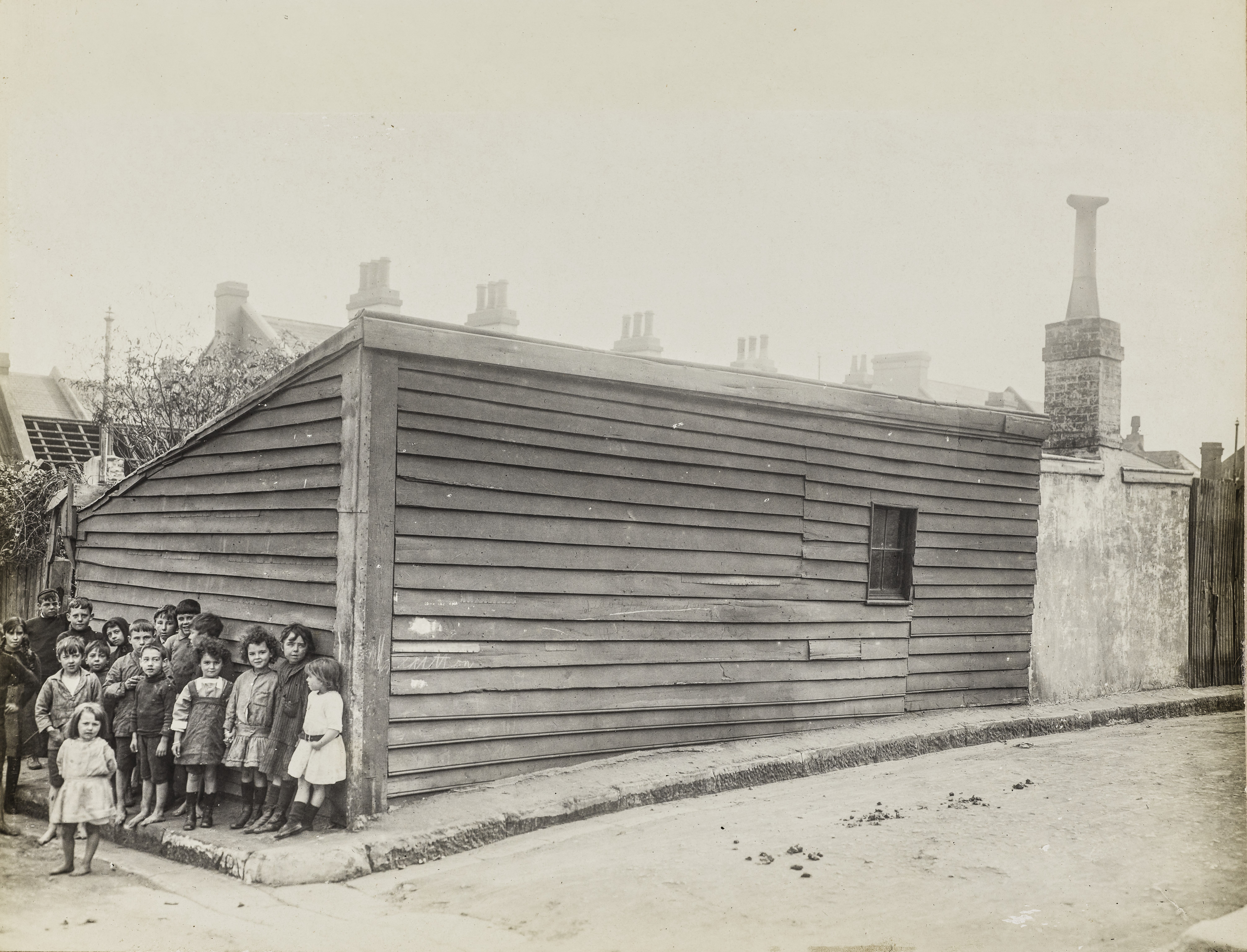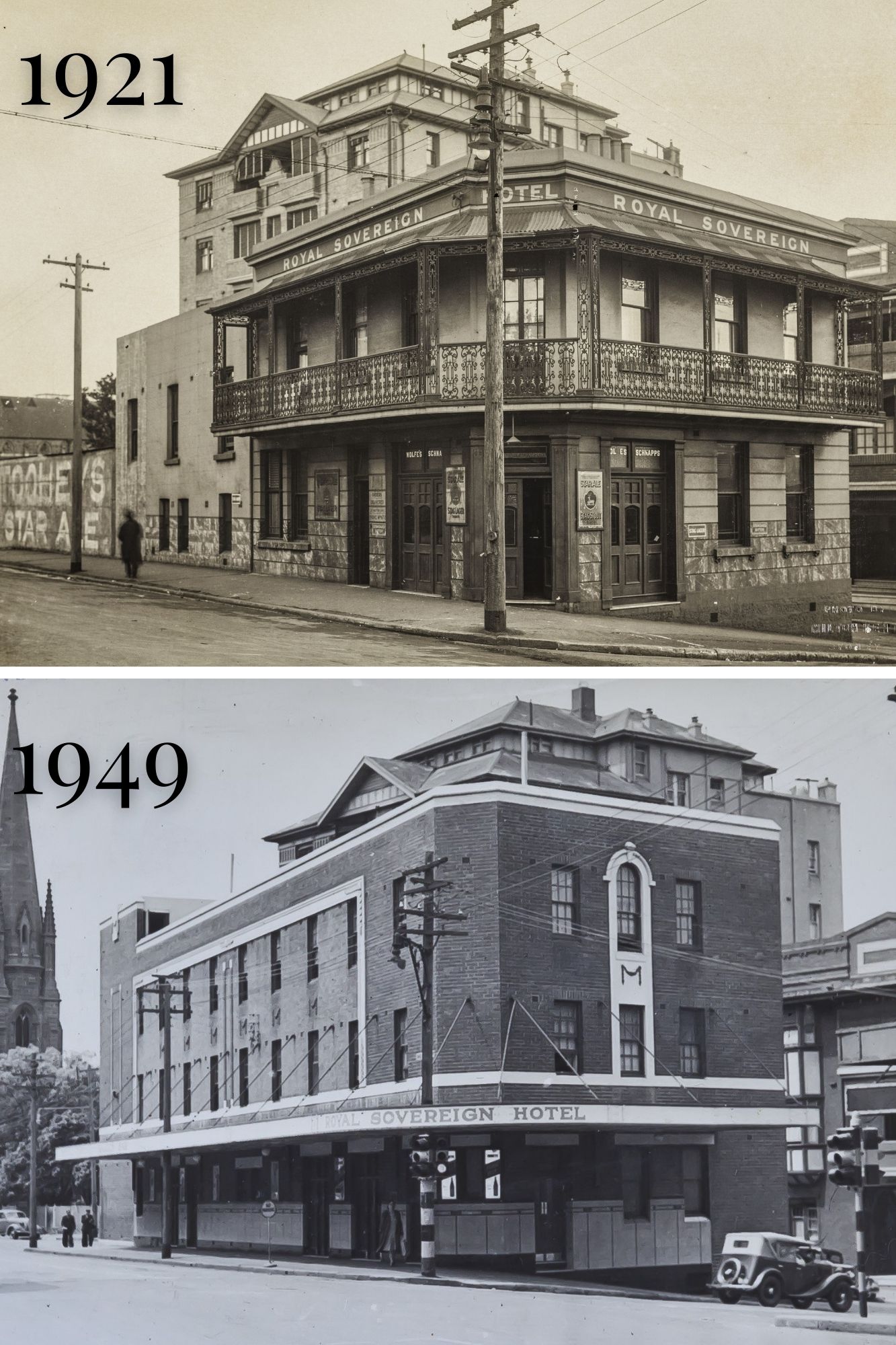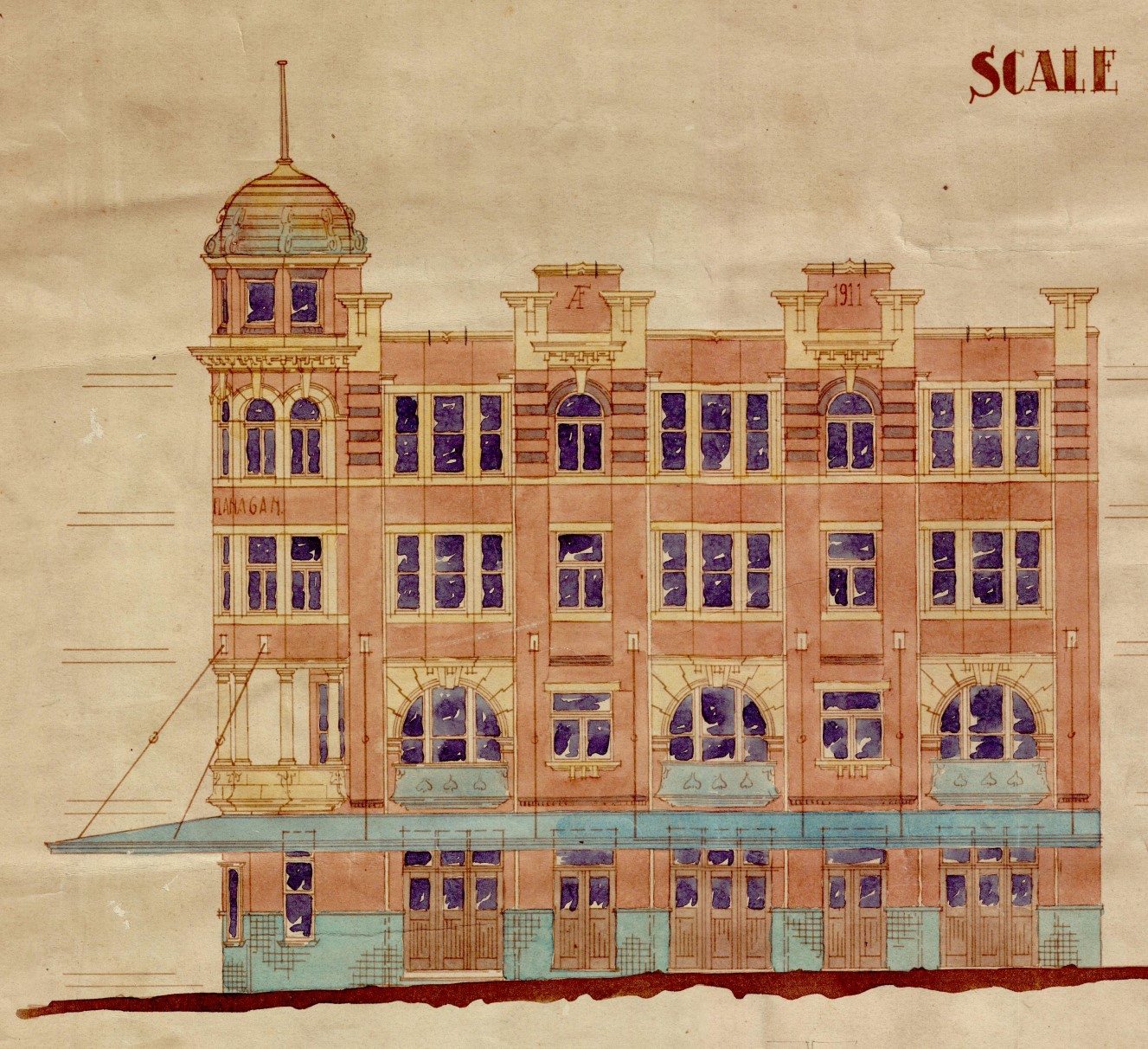
Dwelling in Great Barcom Street, Darlinghurst, 1901
Photograph from Demolition Books, City of Sydney Archives, A-00036186
The land of ‘intolerable stench’
During the late 19th century in Sydney, the ‘remains of the olden time’ described by John Rae were being pulled down. By 1877 for example, Alexander Kennedy’s ‘house and dairy’ on Liverpool Street, Darlinghurst was described as being of ‘rubble’ construction and was demolished by 1882.1
Yet despite the growing population and increase in housing and commercial premises on Liverpool Street, the City of Sydney Archives is full of letters of complaint, petitioning local government authorities for better drainage and sewerage services well into the 1890s.
Samuel Lane, for example, wrote in September 1865 of ’the state of the drainage at the east end of Liverpool Street’, Darlinghurst, which allowed sewage to drain onto his property.2
The rambler of 1864 also provided clues as to the conditions of the ’narrow, queer-looking’ lanes off Liverpool Street. These lanes featured small cottages and shops with poor drainage and odours ‘which are not to be described’, and were, the rambler notes, best crossed with a quicker pace to avoid their unfriendly and mistrustful residents. One man is even seen ‘sweeping from the surface of the cross-street a greenish ammoniacal liquor away into a main-street running towards the Bay’.3

Palmer Street, Darlinghurst, 1917
Photograph from Demolition Books, City of Sydney Archives, A-00036831
Mrs Harriet Sherwin, the wife of Australia’s first fully qualified medical man in private practice, Dr William Sherwin, submitted a petition to local council in August 1878. She complained of the damage being done to her property caused by ‘defective drainage’ from a nearby cowyard. From at least 1855, Harriet and her husband owned five grand, three-storey terraces on Liverpool Street. Sea View Terrace, as the dwellings were originally known, still stand at 337-345 Liverpool Street.4
In 1887 Mr George W Rowe of Sea View Terrace wrote to the mayor of the ’long continued nuisance of an intolerable stench arising from the open traps of the sewer at the front’ of his residence, noting that two of his children were ‘attacked with fever twice’.5
The problems persisted and one ‘Darlinghurst Resident’ wrote a letter to the editor of the Daily Telegraph in 1884, lamenting the ‘filthiness’ of the creek and the ‘polluted atmosphere, taking the shape of a steaming fog’ and the recent outbreaks of typhoid fever among local families.6
In 1891, a letter from William Wild of 348 Liverpool Street noted that during heavy rainfall, water and ‘sewage matter…floats about my yard and out through the fence with Womerah Avenue, and is directly opposite the [Darlinghurst] Public School’. It was, he concluded, ‘very offensive’.7
In 1892, Mr J Davis of 373 Liverpool Street wrote of a ‘very serious nuisance at a butchers yard situated near my house’ on the corner of Darlinghurst Road and Liverpool Street. The smell, he wrote, was ‘unbearable’.8

Dwelling in Woods Lane Darlinghurst, 1902
Photograph from Demolition Books, City of Sydney Archives, A-00036221
A hotel on almost every corner
As the building boom of the late 19th century progressed, more variety in the types of businesses began to emerge on Liverpool Street, Darlinghurst. Booth’s Hydropathic Baths, for example, were established in 1880 on the corner of Liverpool and College streets, opposite today’s Burdekin Hotel. Mr and Mrs Booth claimed to treat everything from rheumatism and heart palpitations to kidney disease and indigestion.

Royal Sovereign Hotel, 1921 and 1949
Photograph from Demolition Books, City of Sydney Archives and Noel Butlin Archives Centre, A-00037301 and N60-YC-620
But it was the ubiquitous Australian pub which featured prominently in life on Liverpool Street. ‘Public houses’ or hotels increased in number and form relatively reliable geographical markers in the archives as they were constructed on street corners or key junctions. The Royal Sovereign Hotel for instance, today’s Darlo Bar on the corner of Darlinghurst Road, was established in at least 1857. The building seen today was constructed in the late 1920s.9
Since at least 1853, the Burdekin Hotel on the corner of Liverpool and Oxford streets has undergone three transformations: from a two-storey public house initially known as the Blind Beggar Inn, to a three-storey ornate brick hotel featuring an imposing tower known as Andy Flanagan’s, until its current iteration as the Art Deco-style Burdekin Hotel.

The three forms of the Burdekin Hotel
Photographs left to right: State Library of NSW, City of Sydney Archives and Noel Butlin Archives Centre, ON 146/157, A-00039080 and N417-601-112

Detail from an elevation plan for Andy Flanagan's Hotel, 29 March 1911
By James Henry Merriman, architect, City of Sydney Archives, A-00543665
Other hotels include the infamous Tradesman’s Arms Hotel, now East Village, which was originally built on the corner of Liverpool and Palmer streets in about 1876, and rebuilt in 1918. It became the favourite drinking hole of the madam and sly-grog queen, Tilly Devine. Also frequented by other criminal figures such as Guido Calletti it became known as ‘The Bloodhouse’ because of the violent scenes which often erupted there.10
It was not just hotels that were remodelled or rebuilt during the 1910s through to the 1930s, Liverpool Street witnessed another key transformation which one famous Australian poet described as follows:
I saw things – buildings that climbed like mad, stone mountains into the clouds….For it is so that the queer suburb of Darlinghurst has cropped and grown – not into waste land, like the expanding districts of the realty-agents, but into waste air – into the clouds themselves.
~ Kenneth Slessor, 192311
Read the next part of the story.
Assessment Book - Fitzroy Ward, 1882 (01/01/1882 - 31/12/1882), [A-01089276]. City of Sydney Archives, https://archives.cityofsydney.nsw.gov.au/nodes/view/1842168. ↩︎
Letter: Samuel Lane of Liverpool Street and Darlinghurst Road, requests that the sewerage drain be (13/09/1865 - 19/09/1865), [A-00294926]. City of Sydney Archives, https://archives.cityofsydney.nsw.gov.au/nodes/view/1096849. ↩︎
‘Rambles through Sydney’, Sydney Morning Herald, 30 May 1864, 3, http://nla.gov.au/nla.news-article13085262. ↩︎
Petition: Harriet Sherwin and other residents of Darlinghurst complaining of the damage to their (12/08/1878), [A-00303080]. City of Sydney Archives, https://archives.cityofsydney.nsw.gov.au/nodes/view/1104999. ↩︎
Letter - Complaint about intolerable stench from sewer, Liverpool Street Darlinghurst, 1887 (20/10/1887 - 27/10/1887), [A-00313773]. City of Sydney Archives, https://archives.cityofsydney.nsw.gov.au/nodes/view/1551101. ↩︎
‘Sewerage of the City and Paddington’, The Daily Telegraph, 23 July 1884, 6, http://nla.gov.au/nla.news-article237261778. ↩︎
Letter - Complaint about poor drainage at 348 Liverpool Street Darlinghurst, 1891 (18/03/1891 - 06/04/1891), [A-00321620]. City of Sydney Archives, https://archives.cityofsydney.nsw.gov.au/nodes/view/1557545. ↩︎
Letter - Complaint about unbearable smell from butcher’s yard, Liverpool Street Darlinghurst, 1892 (07/11/1892 - 10/11/1892), [A-00324416]. City of Sydney Archives, https://archives.cityofsydney.nsw.gov.au/nodes/view/1560337. ↩︎
Darlinghurst Rd and Hardie St (306) and Liverpool St (Royal Sovereign Hotel). New hotel. (01/01/1925 - 31/12/1925), [A-00551692]. City of Sydney Archives, https://archives.cityofsydney.nsw.gov.au/nodes/view/1417576. ↩︎
‘Darlo Village Hotel’, Dictionary of Sydney, https://dictionaryofsydney.org/building/darlo_village_hotel. ↩︎
Kenneth Slessor, ‘The Prisoner of Darlinghurst: A warning to those who have managed to keep their freedom’, The Home 4, no 1, 1 March 1923, 32, http://nla.gov.au/nla.obj-383283960. ↩︎

